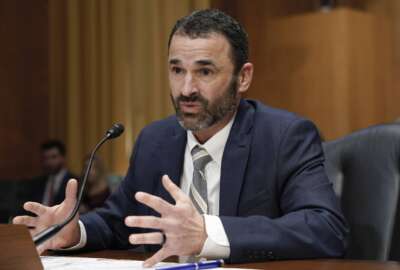Hubbard Radio Washington DC, LLC. All rights reserved. This website is not intended for users located within the European Economic Area.
VA hacks away at claims backlog, increases accuracy
Allison Hickey, VA's undersecretary for benefits, said VBMS has transformed the agency from a paper system to one that mostly relies on electronic data. Some la...
wfedstaff | April 17, 2015 6:58 pm
The Veterans Affairs Department says its claims backlog is at its lowest point today than at any time in the last three years. Officials credit its progress to several changes under its Veterans Benefits Management System (VBMS).
Allison Hickey, VA’s undersecretary for benefits, who spoke last week at the ACT- IAC’s Management of Change conference in Cambridge, Maryland, said VBMS has transformed the agency from a paper system to one that mostly relies on electronic data.
“We have taken more than 52 percent in a single year out of backlog and completed those claims,” she said. “Some might say, ‘Well, yeah, but maybe you are just doing them fast and therefore not paying attention to quality.’ When I arrived in June of 2011, our quality was at 83 percent and our accuracy level was at 83 percent nationally. Today, our accuracy is at 91 percent at the claim level and at 96 percent at each of the issue levels inside of the claim. So no, we aren’t just doing them faster, but we are doing them faster and better.”
Hickey said VA’s disability and benefits claims backlog is down by more than 300,000 over the last year alone. It was at 611,000 in March 2013 and now it’s down to 291,000 as of May 26.
The claims backlog is one of two numbers VA, Congress and veterans organizations pay close attention to, the other being the number of pending claims. These are two different, but related numbers.
The number of pending claims is much higher than the total backlog. VA says there are more than 572,000 claims in its inventory, down from more than 883,000 in July 2012.
The claims backlog shows any veteran who has been waiting for more than 125 days since VA received their paperwork and data.
The claims inventory includes both those under and those in the system for more than 125 days.
System troubles a thing of the past?
At Management of Change 2014 (MOC), Hickey highlighted several successes by VA including completing 1.17 million claims last year. She said in 2014 VA already is 170,000 claims ahead of its efforts last year.
It has not been a smooth electronic transition for VA. VBMS has suffered from periodic but serious latency issues as well as full-blown outages, sometimes several times per day. VA took three years to develop and roll out the paperless system, and lawmakers often question how the agency measures progress.
“We have fundamentally overhauled a complete claims process. We moved from human beings with rubber tips on their fingers going through 5,000 tons of paper in a single year into an environment where we have 88 percent of all of our claims being processed online,” Hickey said in an exclusive interview with Federal News Radio. “In any large scale change like that in the early days, you will have … bumps in the system, and we did and we experienced them. But the positive thing is we reacted quickly to them. I can tell you of late we are not seeing some of those issues happening. In fact, I can tell you we’ve had record-breaking production months of late.”
She added VA expects to process no less than 1.3 million claims this year.
“We now have rules-based calculator and capability built into the system that’s helping us to make sure that our answers are accurate so our accuracy has gone up too,” Hickey said. “I do feel like [VBMS] is stabilized now, and I think we even in the last month added the last final piece of baseline functionality for those employees who actually review and award the claim and make sure it gets paid. That is taking about 15 minutes per claim off the process. Now we are fully from end-to-end completely from all the way to the beginning of having a veteran come online through eBenefits, file their claim online, upload their medical evidence, or have a veteran service organization do the same, and it can go completely paperless through the process and not generate an ounce of paper.”
Metrics are too limited
Despite this progress, some members of Congress remain concerned over VA’s efforts.
“To date, the VA has made progress on tackling their backlog and focusing on the oldest claims, as the VA is, is a good thing to do,” said a spokesperson for Rep. Mike Michaud (D-Maine), the ranking member of the Veterans Affairs Committee. “While we have seen good progress on those older claims considered to be a substantial part of the backlog, other claims that are not considered in this distinct workload related to veterans ‘disability entitlement claims’ have unfortunately risen — such as wait times associated with appeals or injured service members waiting on the VA for a rating to get their medical discharge.”
Sen. Richard Burr (R-N.C.), ranking member of the Veterans Affairs Committee, said in an emailed statement that VA’s backlog stats look good on paper, but the way they measure progress is too narrow.
“We should question whether VA has been ‘gaming’ its backlog numbers, just like they did with health care wait times,” Burr said. “Just last week, the Inspector General found that VA was not accurately reporting the time it takes to process certain claims from service members leaving the military and found an accuracy rate of only 69 percent with respect to those claims.”
Burr is referring to an audit of VA’s Quick Start program, which found problems with timeliness and accuracy of certain claims. While the progress on the backlog as defined by the VA is an important step in the right direction, we need to move toward eliminating the backlog in its entirety, to include the wait for all VA services and benefits, and providing timely services for all veterans so that they receive the high-quality care that they deserve — and that they’ve earned,” the spokesperson for Michaud said.
Hickey said VA knows very well there still is a lot of work to do to meet its goal of eliminating the entire backlog of claims by the end of 2015.
She said a new awards functionality will continue to help speed up and improve accuracy of the process.
“The awards functionality is a review of the claims decision made by the rater and it’s also where a review of the amount of money that we would send to the veteran. A lot of that can now happen automatically for a large number of our claims,” Hickey said. “What happens then is that gets registered in the system, it goes as a file to Treasury and Treasury pays that so it’s a very rapid source of information flow. The other thing it does is it triggers up into eBenefits the status of the claim telling the veteran or the veteran service officer who’s supporting them in the process that the claim decision has been made, it has been paid and here’s the amount. It also from this point forward tells the veteran every month that we’ve paid this for your monthly allotment so they can check to see their payments occurred in an electronic environment.”
Data sharing with DoD needs work
Hickey also is holding high hopes for an information sharing system VA and the Defense Department launched on Jan. 1.
The Health Artifact and Image Management Solution (HAIMS) is supposed to send VBMS a complete, certified and final military medical record for any veteran who left the military after Jan. 1.
But the two systems continue to struggle around integration.
Hickey said the accuracy rate of the data coming from DoD is lacking and slow — 81 percent of the records are taking more than 45 days to transfer.
“DoD is still working to getting caught up to the ones we need so right now, yes, about 81 percent of the ones we are asking for are past the 45 days that they have to deliver them,” she said. “We’re hoping they get caught up quickly. They’ve committed to us to get caught up quickly. But we need those to go fast. We need all that evidence to make a really good decision on behalf of that veteran, family member or survivor. So we are really hooked to what DoD gives us.”
Hickey said it’s also not just about technology improvements.
She said VA employees and claims processors are receiving better training that includes live, interactive and focused education on solving real cases.
VA also is using focused training for specific employees who are struggling in one or two areas of processing claims.
Finally, VA implemented segmented lanes where groups of experts focus on one part the process, but the difference is all three lanes communicating better to create a cross-functional process around claims processing, and expediting those that are less complex through the VBMS system, Hickey said.
Agile software development
The upcoming VBMS technology improvements include a more collaborative software development process.
Hickey said she paired some of her best claims processors with the software developers to make sure they meet the needs of the users upfront.
“They have done that with the disability benefit questionnaires but we are still building on those. Those are questionnaires that we now have out there first on paper, now on electronic format and increasingly into a better user interface by December of this year that makes it easier for a doctor to fill it out on their side from a user experience on their side, which is different from how the rater needs to see the information so lots of GUI layers in between with lots of different facing user information available to them. We are doing that literally right now. We learned the way we built it where everybody did it on the same user interface didn’t work. Doctors didn’t like it when it looked like what we needed and we weren’t liking it when it turned into what they needed. So now we will have whatever customized user interface you need to have for whatever sense of business you are doing.”
She said VA creates design teams made of IT, agency and industry stakeholders and other veteran benefit organizations, who then develop playbooks to detail goals and metrics.
Hickey said future additions to VBMS include everything from integrating pension and education data to mobile apps to appeals to centralized mail.
“We have lots of focus groups right now to ask veterans about their experience,” she said. “We are in the world. We’re in the 21st century. We are making a difference every single day to veterans. Are we fully there yet? No, but we are committed to no celebration until we get there.”
RELATED STORIES:
VA’s disability claims backlog down by 44 percent, but problems remain
Doubts remain over VA’s ability to end huge disability claims backlog
VA gets new tool to speed up claims processing, reduce backlog
Copyright © 2024 Federal News Network. All rights reserved. This website is not intended for users located within the European Economic Area.
Jason Miller
Jason Miller is executive editor of Federal News Network and directs news coverage on the people, policy and programs of the federal government.
Follow @jmillerWFED





